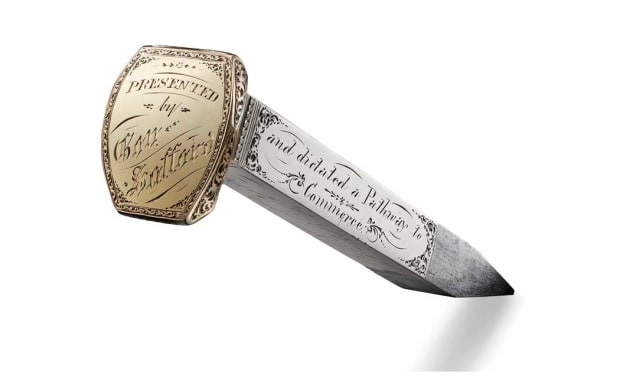#Fast #Track #Transcontinental #Railroad #Spike #Sells #Million
‘The Arizona Spike,’ a steel spike clad in gold and silver that commemorated the completion of the Transcontinental Railroad in 1869, roars past pre-auction estimates at Christie’s.
A steel railroad spike clad in gold and silver, used in the ceremonial completion of the transcontinental railroad, sold for $2.22 million at Christie’s, smashing its pre-sale estimate of $300,000–$500,000.
A little more than five inches long, the Arizona Spike was the headliner of Christie’s “The Exceptional Sale,” featuring singular works of historic importance, as well as iconic objects of popular culture. Belonging to the Museum of the City of New York, the piece was sold to benefit the museum’s collection.
Courtesy of Christie’s
“This was a one-of-a-kind piece of historic importance and we knew it would be the subject of intense competition among collectors,” Peter Klarnet, Christie’s Vice President, Senior Specialist Americana, told Artnet News. “In the end, the value soared past our expectations.”
The spike was crafted to commemorate the completion of the world’s first transcontinental railroad in 1869, joining the eastern and western halves of the United States and connecting California with the industrial centers of the east.

Courtesy of Christie’s
In 1862, the Pacific Railroad Act chartered the Central Pacific and the Union Pacific Railroad Companies, tasking them with building a transcontinental railroad that would link the United States from east to west. Over the next seven years, the two companies would race toward each other from Sacramento, California, on the one side to Omaha, Nebraska, on the other, struggling against great risks before they met at Promontory, Utah, on May 10, 1869.
The railroad’s construction is considered one of nation’s greatest technological feats of the 19th century, allowing commerce to thrive throughout the country. With the completion of the track, the travel time for making the 3,000-mile journey across the U.S. was cut from a matter of months to under a week.
You May Also Like:
Railroad Memorabilia Building Up Head of Steam in Marketplace

